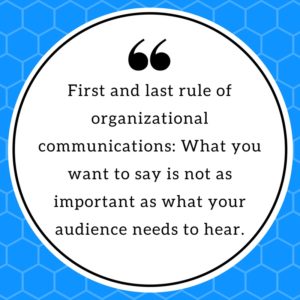
Pixabay
One marble on the sidewalk is one you will likely notice. But if there are 10 or 20, it will be more difficult to pick out one. Fifty and none will likely stand out. Unless there is something about that marble that catches your attention. And that, folks, is what web writing is like. Content is everywhere on the web. Not that I have to tell you that. “Read this.” “You will be a better person if you read this.” “This will make you laugh.” “This will make you cry.”
If you are writing any kind of web content—a blog post or newsletter article, a website section, or almost anything else—you need to make sure your writing stands out. How do you do that?
Write for your audience. Do you know who they are and what they want? Are you engaging in conversations so you are current on what interests them and what their needs are? This is probably the single most important component of making your writing matter. Someone who needs something is going to look and find it. Make sure you are writing what your audience needs.
Make sure your writing is the best it can be. I like the three Cs: clear, concise, and correct. Need a fourth C? Make it creative. Creative enough to attract readers and keep them. If their attention wanders before they get to the second paragraph, the writing isn’t doing its job.
Find your metaphorical panda bear. Let’s leave our metaphorical marble for a moment to consider the cute and cuddly panda bear. People love panda bears so they look at them. You need a panda bear. Or as professional writers call it: a hook to engage your audience. Is there a news angle to what you are writing about? What is your intended audience reading about? Talking about? Use that. The better you know your audience, the easier it will be to figure out how to catch their attention and focus them on your content. If you do that reliably, they will come back to you for more.
Write an inviting headline. Like the old-fashioned carnival barker, your headline should call the audience to step right up and read. To make sure they are engaged enough to continue to the content, make your headline specific, focused on audience needs, and clear about the content’s topic. Creative is great but only if the headline is also clear. Above all, you want the audience to know what the article is about and why they need to read it.
Use photos, graphics, and video that relate to your content. It’s best, if possible, to use photos and graphics that specifically relate to your organization. If not, you can find free images on websites like Pixabay and Pexels. Be careful not to simply grab any photo or graphic from the web. You must have permission to use someone else’s work, whether it’s an infographic, photo, or graphic. There are a number of websites that allow you to easily create professional graphics and use them, including infographics. Two of my favorites are Canva and Piktochart. I created this simple graphic with Canva in about five minutes:
Use social media channels to promote your writing. It is best at this point to make sure you know what social media channels your audiences use and then use those to promote your content.
Now go forth and make those marbles and panda bears proud to be yours.
Sherri Alms has been writing content designed to appeal to her clients’ audiences for more than 20 years. Email her to discuss your organization’s writing needs.

